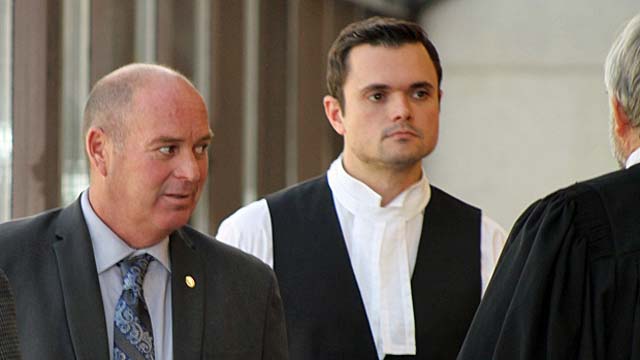
Sherbrooke Quebec - Tom Harding, the locomotive engineer indicted for his role in the 2013 Lake Megantic rail disaster, didn't cause the tragedy, his defence lawyer said Monday.
Speaking before a packed courtroom, Charles Shearson, one of Harding's lawyers, asked jurors to recall the testimony of the Crown's expert witness, Stephen Callaghan.
Callaghan analyzed information gathered from the locomotive's black box and told the court Harding did not properly test the train's handbrakes before leaving the fuel-laden train idling on the tracks the night the runaway train rolled into Lake Megantic and derailed.
"Harding did not do an efficiency test in perfect compliance," said Shearson.
"So Callaghan's conclusion was not that Harding caused the accident, but that he did not prevent it," he said.
"But a lot could have prevented the event."
Harding is one of three former Montreal Maine & Atlantic (MMA) employees charged with 47 counts of criminal negligence causing death in connection with the derailment and ensuing explosions which killed 47 people.
Also charged are former operations manager Jean Demaitre and ex-rail traffic controller Richard Labrie.
Harding, Labrie, and Demaitre all waived their right to present a formal defence and did not testify.
Other Pieces of the Puzzle
Shearson asked jurors to recall the testimony of several Crown witnesses which lends support to his claim that many factors could have prevented the accident.
"What if MMA had done different route planning," he asked, "or if derailers had been made available?"
Shearson also reminded jurors that the accident may also have been prevented had the locomotive's safety system been calibrated in a different way.
Earlier in the trial, the court heard that an automatic penalty brake application never engaged when firefighters shut down the lead locomotive just an hour before the train ran away, after a fire broke out in the smokestack of the locomotive because of a retrofit in the wiring.
"Maybe if there was no fire, there would have been no accident," said Shearson, adding "there is no evidence to establish the cause of the fire. Isn't that an important piece of the puzzle?"
Harding Right to Keep Locomotive Running
The Crown has argued that Harding didn't apply enough handbrakes to the train.
It also said Harding should never have relied on the locomotive's air brakes to secure the train.
Shearson countered that Monday, pulling out MMA's general operating instructions, which indicate the lead locomotive should be left running with its independent brake engaged when left unattended.
Shearson said Harding wasn't in perfect compliance in the way he tested the train's brakes.
But he said Harding did do an efficiency test.
Recalling Callaghan's analysis of the black box data, Shearson told jurors that when Harding left that train it had more than two and a half times the force required to hold it.
"It was not going anywhere," he said.
Shearson told the court that the Crown had said Harding had been made aware firefighters had shut down the locomotive after the fire.
But on Monday, Shearson said that wasn't true.
"Harding was never told that the 5017 was shut down," he said, implying there was a miscommunication at some point along the way.
Harding An Easy Target
Earlier in his closing arguments Monday, Shearson asked jurors to remember that the investigators who searched the MMA offices after the tragedy testified they were specifically looking for documents pertaining to Harding.
"It put him in an unfair spotlight," Shearson said.
"It made him an easy target to shift responsibility to."
Shearson plainly told Superior Court Justice Gaetan Dumas and the 14 jurors that Harding isn't perfect and didn't secure his train according to regulation.
But he said it's unfair to judge Harding for not being perfect.
"That's a high standard, to hold someone to perfection and then not accept responsibility," said Shearson.
"Although Harding's conduct was not perfect it was reasonable. When you look at the entirety of the evidence you have the image of a very reliable man."
Shearson listed a number of other factors that contributed to the derailment, including the degraded condition of the tracks and MMA's failure to conduct a risk assessment on the consequences of parking a heavy fuel train on a slope at Nantes, 13 kilometres from downtown Lake Megantic.
"If there was a risk at Nantes, no one, not management, no one at MMA, or Transport Canada, foresaw the problem," said Shearson.
"So how can we blame Harding for not foreseeing the risk?"
Safety of One-Man Crews Called into Question
Switching between English and French, Shearson highlighted the relatively new practice of one-man crews, in which locomotive engineers were forced to secure their trains alone.
He reminded jurors that Crown witness Steve Jacques, an MMA rail traffic controller, had testified that after the rail disaster, MMA put out a memo instructing locomotive engineers who operated one man-crews to tell the rail traffic controller on duty how many handbrakes they'd applied to their parked train.
Jacques had testified before that instruction came down, rail traffic controllers had refused to follow the directive because it put too much responsibility on them.
"Not only did some persons at the company not want the responsibility," said Shearson, "they would not accept it."
Shearson asked jurors if it was reasonable to think that all employees at the company should be on par with implementing safety standards.
Closing statements for Harding continue Tuesday.
The Crown delivered closing arguments in Sherbrooke, last week, as did lawyers representing Labrie and Demaitre.
Alison Brunette.
under the provisions in
Section 29 of the Canadian
Copyright Modernization Act.



